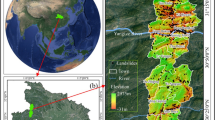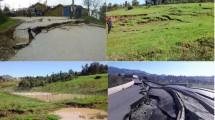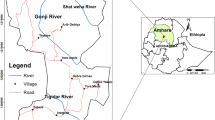Abstract
This study investigates the application of information value (InV) and logistic regression (LR) models for producing landslide susceptibility maps (LSMs) of the Zigui–Badong area near the Three Gorges Reservoir in China. This area is subject to anthropogenic influences because the reservoir’s water level cyclically fluctuates between 145 and 175 m. In addition, the area suffers from extreme rainfall events due to the local climate and has experienced significant and widespread landslide events in recent years. In this study, a landslide inventory map was initially constructed using field surveys, aerial photographs, and a literature search of historical landslide records. Eight causative factors, including lithology, bedding structure, slope, aspect, elevation, profile curvature, plane curvature, and fractional vegetation cover, were then considered in the generation of LSMs by using the InV and LR models. Finally, the prediction performances of these maps were assessed through receiver operating characteristics (ROC) that utilized both success-rate and prediction-rate curves. The validation results showed that the area under the ROC curve for the InV model was 0.859 for the success-rate curve and 0.865 for prediction-rate curve; these results indicate the InV model surpassed the LR model (0.742 for success-rate curve and 0.740 for prediction-rate curve). Overall, the two models provided nearly similar results. The results of this study show that landslide susceptibility mapping in the Zigui–Badong area is viable with both approaches.
















Similar content being viewed by others
References
Akgun A, Turk N (2010) Landslide susceptibility mapping for Ayvalik (Western Turkey) and its vicinity by multicriteria decision analysis. Environ Earth Sci 61(3):595–611
Akgun A, Kıncal C, Pradhan B (2011) Application of remote sensing data and GIS for landslide risk assessment as an environmental threat to Izmir city (west Turkey). Environ Monit Assess 184(9):5453–5470
Atkinson PM, Massari R (1998) Generalized linear modeling of susceptibility to landsliding in the central Apennines, Italy. Comput Geosci 24(4):373–385
Ayalew L, Yamagishi H (2005) The application of GIS-based logistic regression for landslide susceptibility mapping in the Kakuda-Yahiko Mountains, Central Japan. Geomorphology 65(1):15–31
Bai SB, Wang J, Zhang FY, Pozdnoukhov A, Kanevski MF (2008) Prediction of landslide susceptibility using logistic regression: a case study in Bailongjiang River Basin, China. In: Proceedings of the 4th international conference on natural computation, Jinan, China, pp 25–27
Bai SB, Wang J, Lu GN, Zhou PG, Hou SS, Xu SN (2009) GIS-based and data-driven bivariate landslide-susceptibility mapping in the Three Gorges Area. China. Pedosphere 19(1):14–20
Bai SB, Wang J, Lu GN, Zhou PG, Hou SS, Xu SN (2010) GIS-based logistic regression for landslide susceptibility mapping of the Zhongxian segment in the Three Gorges area, China. Geomorphology 115(1):23–31
Balasubramani K, Kumaraswamy K (2013) Application of geospatial technology and information value technique in landslide hazard zonation mapping: a case study of Giri Valley, Himachal Pradesh. Disaster Adv 6(1):38–47
Bathrellos GD, Kalivas DP, Skilodimou HD (2009) GIS-based landslide susceptibility mapping models applied to natural and urban planning in Trikala, Central Greece. Estud Geol 65(1):49–65
Bathrellos GD, Gaki-Papanastassiou K, Skilodimou HD, Papanastassiou D, Chousianitis KG (2012) Potential suitability for urban planning and industry development by using natural hazard maps and geological—geomorphological parameters. Environ Earth Sci 66(2):537–548
Bathrellos GD, Gaki-Papanastassiou K, Skilodimou HD, Skianis GA, Chousianitis KG (2013) Assessment of rural community and agricultural development using geomorphological—geological factors and GIS in the Trikala prefecture (Central Greece). Stoch Environ Res Risk Assess 27(2):573–588
Brabb EE (1991) The world landslide problem. Episodes 14(1):52–61
Brenning A (2005) Spatial prediction models for landslide hazards: review, comparison and evaluation. Nat Hazards Earth Syst Sci 5(6):853–862
Cevik K, Topal T (2003) GIS-based landslide susceptibility mapping for a problematic segment of the natural gas pipeline, Hendek (Turkey). Environ Geol 44(8):949–962
Che VB, Kervyn M, Suh CE, Fontijn K, Ernst GGJ, del Marmol MA, Trefois P, Jacobs P (2012) Landslide susceptibility assessment in Limbe (SW Cameroon): a field calibrated seed cell and information value method. Catena 92:83–98
Chen QX, Hu HT, Sun Y, Tan CX (1995) Assessment of regional crustal stability and its application to engineering geology in China. Episodes 18(1):69–72
Chen YR, Chen JY, Hsieh SC, Ni PN (2009) The application of remote sensing technology to the interpretation of land use for rainfall-induced landslides based on genetic algorithms and artificial neural networks. IEEE J-STARS 2(2):87–95
Chen T, Niu RQ, Li PX, Zhang LP, Du B (2011a) Regional soil erosion risk mapping using RUSLE, GIS, and remote sensing: a case study in Miyun Watershed, North China. Environ Earth Sci 63(3):533–541
Chen T, Niu RQ, Wang Y, Li PX, Zhang LP, Du B (2011b) Assessment of spatial distribution of soil loss over the upper basin of Miyun reservoir in China based on RS and GIS techniques. Environ Monit Assess 179(1–4):605–617
Chen T, Niu RQ, Du B, Wang Y (2015) Landslide spatial susceptibility mapping by using GIS and remote sensing techniques: a case study in Zigui County, the Three Georges reservoir, China. Environ Earth Sci 73(9):5571–5583
Chung CJF, Fabbri AG (2003) Validation of spatial prediction models for landslide hazard mapping. Nat Hazards 30(3):451–472
Dai FC, Lee CF, Xu ZW (2001) Assessment of landslide susceptibility on the natural terrain of Lantau Island, Hong Kong. Environ Geol 40(3):381–391
Devkota KC, Regmi AD, Pourghasemi HR, Yoshida K, Pradhan B, Ryu IC, Dhital MR, Althuwaynee OF (2013) Landslide susceptibility mapping using certainty factor, index of entropy and logistic regression models in GIS and their comparison at Mugling-Narayanghat road section in Nepal Himalaya. Nat Hazards 65(1):135–165
Duman TY, Can T, Gokceoglu C, Nefeslioglu HA, Sonmez H (2006) Application of logistic regression for landslide susceptibility zoning of Cekmece Area, Istanbul, Turkey. Environ Geol 51(2):241–256
Fourniadis IG, Liu JG, Mason PJ (2007) Landslide hazard assessment in the Three Gorges area, China, using ASTER imagery: Wushan-Badong. Geomorphology 84(1):126–144
Glade T (2003) Landslide occurrence as a response to land use change: a review of evidence from New Zealand. Catena 51(3):297–314
Guzzetti F, Carrara A, Cardinali M, Reichenbach P (1999) Landslide hazard evaluation: a review of current techniques and their application in a multi-scale study, central Italy. Geomorphology 31(1):181–216
He KQ, Li XR, Yan XQ, Guo D (2008) The landslides in the Three Gorges Reservoir Region, China and the effects of water storage and rain on their stability. Environ Geol 55(1):55–63
Hosmer DW, Lomeshow S (2000) Applied logistic regression. Wiley, New York
Hubei Province Geological Survey (1997) Geological Map of Zigui and Badong County (1:50,000) 1997 Hubei Province Geological Survey Press, Wuhan (in Chinese)
Intarawichian N, Dasananda S (2011) Frequency ratio model based landslide susceptibility mapping in lower Mae Chaem watershed, Northern Thailand. Environ Earth Sci 64(8):2271–2285
Kayastha P, Dhital MR, De Smedt F (2013) Evaluation and comparison of GIS based landslide susceptibility mapping procedures in Kulekhani watershed, Nepal. J Geol Soc India 81(2):219–231
Lee S (2005) Application of logistic regression model and its validation for landslide susceptibility mapping using GIS and remote sensing data. Int J Remote Sens 26(7):1477–1491
Lee S, Min K (2001) Statistical analysis of landslide susceptibility at Yongin, Korea. Environ Geol 40(9):1095–1113
Lee S, Pradhan B (2007) Landslide hazard mapping at Selangor, Malaysia using frequency ratio and logistic regression models. Landslides 4(1):33–41
Lee S, Choi J, Min K (2004) Probabilistic landslide hazard mapping using GIS and remote sensing data at Boun, Korea. Int J Remote Sens 25(11):2037–2052
Li JJ, Xie SY, Kuang MS (2001) Geomorphic evolution of the Yangtze Gorges and the time of their formation. Geomorphology 41(2):125–135
Liu JG, Mason PJ, Clerici N, Chen S, Davis A, Miao F, Deng H, Liang L (2004) Landslide hazard assessment in the Three Gorges area of the Yangtze River using ASTER imagery: Zigui-Badong. Geomorphology 61(1):171–187
Liu CZ, Liu YH, Wen MS, Li TF, Lian JF, Qin SW (2009) Geo-hazard initiation and assessment in the three gorges reservoir. Landslide Disaster Mitigation in Three Gorges Reservoir, China. Springer, Berlin, pp 3–40
Meentemeyer RK, Moody A (2000) Automated mapping of conformity between topographic and geological surfaces. Comput Geosci 26(7):815–829
Nefeslioglu HA, Duman TY, Durmaz S (2008) Landslide susceptibility mapping for a part of tectonic Kelkit Valley (Eastern Black Sea region of turkey). Geomorphology 94(3):401–418
Nourani V, Pradhan B, Ghaffari H, Sharifi SS (2014) Landslide susceptibility mapping at Zonouz Plain, Iran using genetic programming and comparison with frequency ratio, logistic regression, and artificial neural network models. Nat Hazards 71(1):523–547
Oh HJ, Kim YS, Choi JK, Lee S (2011) GIS mapping of regional probabilistic groundwater potential in the area of Pohang City, Korea. J Hydrol 399(3):158–172
Ozdemir A, Altural T (2013) A comparative study of frequency ratio, weights of evidence and logistic regression methods for landslide susceptibility mapping: Sultan Mountains, SW Turkey. J Asian Earth Sci 64:180–197
Papadopoulou-Vrynioti K, Bathrellos GD, Skilodimou HD, Kaviris G, Makropoulos K (2013) Karst collapse susceptibility mapping using seismic hazard in a rapid urban growing area. Eng Geol 158:77–88
Peng L, Niu RQ, Huang B, Wu XL, Zhao YN, Ye RQ (2014) Landslide susceptibility mapping based on rough set theory and support vector machines: a case of the Three Gorges area, China. Geomorphology 204:287–301
Pourghasemi HR, Pradhan B, Gokceoglu C, Mohammadi M, Moradi HR (2013) Application of weights-of-evidence and certainty factor models and their comparison in landslide susceptibility mapping at Haraz watershed, Iran. Arab J Geosci 6(7):2351–2365
Pourghasemi HR, Moradi HR, Aghda SMF, Gokceoglu C, Pradhan B (2014) GIS-based landslide susceptibility mapping with probabilistic likelihood ratio and spatial multi-criteria evaluation models (North of Tehran, Iran). Arab J Geosci 7(5):1857–1878
Pradhan B (2010) Landslide susceptibility mapping of a catchment area using frequency ratio, fuzzy logic and multivariate logistic regression approaches. J Indian Soc Remote Sens 38(2):301–320
Pradhan B (2013) A comparative study on the predictive ability of the decision tree, support vector machine and neuro-fuzzy models in landslide susceptibility mapping using GIS. Comput Geosci 51:350–365
Pradhan B, Lee S (2010) Delineation of landslide hazard areas on Penang Island, Malaysia, by using frequency ratio, logistic regression, and artificial neural network models. Environ Earth Sci 60(5):1037–1054
Pradhan B, Mansor S, Pirasteh S, Buchroithner F (2011) Landslide hazard and risk analyses at a landslide prone catchment area using statistical based geospatial model. Int J Remote Sens 32(14):4075–4087
Ramakrishnan D, Ghose MK, Chandran RV, Jeyaram A (2005) Probabilistic techniques, GIS and remote sensing in landslide hazard mitigation: a case study from Sikkim Himalayas, India. Geocarto Int 20(4):53–58
Regmi AD, Devkota KC, Yoshida K, Pradhan B, Pourghasemi HR, Kumamoto T, Akgun A (2014) Application of frequency ratio, statistical index, and weights-of-evidence models and their comparison in landslide susceptibility mapping in Central Nepal Himalaya. Arab J Geosci 7(2):725–742
Rozos D, Bathrellos GD, Skilodimou HD (2011) Comparison of the implementation of Rock Engineering System (RES) and Analytic Hierarchy Process (AHP) methods, based on landslide susceptibility maps, compiled in GIS environment. A case study from the Eastern Achaia County of Peloponnesus, Greece. Environ Earth Sci 63(1):49–63
Rozos D, Skilodimou HD, Loupasakis C, Bathrellos GD (2013) Application of the revised universal soil loss equation model on landslide prevention. An example from N. Euboea (Evia) Island, Greece. Environ Earth Sci 70(7):3255–3266
Sarkar S, Roy AK, Martha TR (2013) Landslide susceptibility assessment using Information Value Method in parts of the Darjeeling Himalayas. J Geol Soc India 82(4):351–362
Shahabi H, Khezri S, Ahmad BB, Hashim M (2014) Landslide susceptibility mapping at central Zab basin, Iran: a comparison between analytical hierarchy process, frequency ratio and logistic regression models. Catena 115:55–70
Süzen ML (2002) Data driven landslide hazard assessment using geographical information systems and remote sensing. PhD Thesis, Middle East Technical University, Turkey
Süzen ML, Doyuran V (2004) A Comparison of the GIS based landslide susceptibility assessment methods: multivariate versus bivariate. Environ Geol 45(5):665–679
Swets JA (1988) Measuring the accuracy of diagnostic systems. Science 240(4857):1285–1293
Talebi A, Uijlenhoet R, Troch PA (2007) Soil moisture storage and hillslope stability. Nat Hazards Earth Syst Sci 7(5):523–534
Vijith H, Rejith PG, Madhu G (2009) Using InfoVal method and GIS techniques for the spatial modelling of landslide susceptibility in the upper catchment of river Meenachil in Kerala. J Indian Soc Remote Sens 37(2):241–250
Wen BP, Wang SJ, Wang EZ, Zhang JM (2004) Characteristics of rapid giant landslides in China. Landslides 1(4):247–261
Wilson JP, Gallant JC (2000) Terrain analysis principles and applications. Wiley, New York
Wu SR, Shi L, Wang RJ, Tan CX, Hu DG, Mei YT, Xu RC (2001) Zonation of the landslide hazards in the forereservoir region of the Three Gorges Project on the Yangtze River. Eng Geol 59(1):51–58
Wu SR, Jin YM, Zhang YS, Shi JS, Dong C, Lei WZ, Shi L, Tan CX, Hu DG (2004) Investigations and assessment of the landslide hazards of Fengdu County in the reservoir region of the Three Gorges project on the Yangtze River. Environ Geol 45(4):560–566
Yan TZ (1988) Recent advances of quantitative prognoses of landslide in China. In: Proceedings of the fifth international symposium on landslides, Lausanne, Switzerland, vol 2, pp 1263–1268
Yesilnacar E, Topal T (2005) Landslide susceptibility mapping: a comparison of logistic regression and neural networks methods in a medium scale study, Hendek region (Turkey). Eng Geol 79(3):251–266
Yin KL, Yan TZ (1988) Statistical prediction models for slope instability of metamorphosed rocks. In: Proceedings of the fifth international symposium on landslides, Lausanne, Switzerland, vol 2, pp 1269–1272
Youssef AM, Maerz NH (2013) Overview of some geological hazards in the Saudi Arabia. Environ Earth Sci 70(7):3115–3130
Acknowledgments
This work was funded in part by the CRSRI Open Research Program (CKWV2013221/KY), in part by the Natural Science Foundation of Hubei Province (2012FFB06501), and in part by the National High Technology Research and Development Program of China (2012AA121303).
Author information
Authors and Affiliations
Corresponding author
Additional information
This article is part of a Topical Collection in Environmental Earth Sciences on “Environmental Research of the Three Gorges Reservoir,” guest edited by Binghui Zheng, Shengrui Wang, Yanwen Qin, Stefan Norra, and Xiafu Liu.
Rights and permissions
About this article
Cite this article
Chen, T., Niu, R. & Jia, X. A comparison of information value and logistic regression models in landslide susceptibility mapping by using GIS. Environ Earth Sci 75, 867 (2016). https://doi.org/10.1007/s12665-016-5317-y
Received:
Accepted:
Published:
DOI: https://doi.org/10.1007/s12665-016-5317-y




